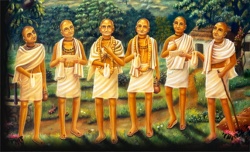Parampara
Parampara (Sanskrit: परम्परा, paramparā) denotes a succession of teachers and disciples in traditional Indian culture and Indian religions such as Hinduism, Sikhism, Jainism and Buddhism. It is also known as guru-shishya paramparā ("succession from guru to disciple").
The Sanskrit word literally means an uninterrupted row or series, order, succession, continuation, mediation, tradition.In the traditional residential form of education, the shishya remains with his or her guru as a family member and gets the education as a true learner.
In some traditions there is never more than one active master at the same time in the same guruparamaparya (lineage).
In the paramparā system, knowledge (in any field) is passed down (undiluted) through successive generations. E.g. division of Veda and its transfer through paramparas describes Bhagavata Purana.
The fields of knowledge taught may include, for example, spiritual, artistic (music or dance) or educational.
Titles of Gurus in Parampara
In paramapara, not only is the immediate guru revered, the three preceding gurus are also worshipped or revered. These are known variously as the kala-guru or as the "four gurus" and are designated as follows:
Guru - the immediate guru Parama-guru - the Guru's guru Parameshti-guru - the Parama-guru's guru
